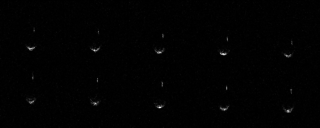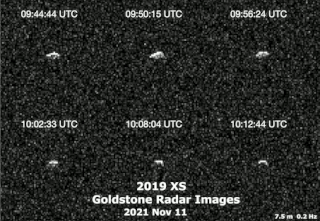
4769 Castalia is a near-Earth object and potentially hazardous asteroid of the Apollo group, approximately 1.4 kilometers in diameter and was the first asteroid to be modeled by radar imaging. It was discovered on 9 August 1989, by American astronomer Eleanor Helin (Caltech) on photographic plates taken at Palomar Observatory in California. It is named after Castalia, a nymph in Greek mythology. It is also a Mars- and Venus-crosser asteroid.

4179 Toutatis is an elongated, stony asteroid and slow rotator, classified as a near-Earth object and potentially hazardous asteroid of the Apollo asteroid and Alinda asteroid groups, approximately 2.5 kilometers in diameter. Discovered by French astronomer Christian Pollas at Caussols in 1989, the asteroid was named after Toutatis from Celtic mythology.
1998 KY26 is a nearly spherical sub-kilometer asteroid, classified as a near-Earth object of the Apollo group. It measures approximately 30 meters (100 feet) in diameter and is a fast rotator, having a rotational period of only 10.7 minutes. It was first observed on 2 June 1998, by the Spacewatch survey at Kitt Peak National Observatory during 6 days during which it passed 800,000 kilometers (half a million miles) away from Earth (a little more than twice the Earth–Moon distance).

1862 Apollo is a stony asteroid, approximately 1.5 kilometers in diameter, classified as a near-Earth object (NEO). It was discovered by German astronomer Karl Reinmuth at Heidelberg Observatory on 24 April 1932, but lost and not recovered until 1973.

(612901) 2004 XP14 is a sub-kilometer asteroid, classified as a near-Earth object and potentially hazardous asteroid of the Apollo group. It was first observed by the LINEAR project on 10 December 2004.
(179806) 2002 TD66 (also written 2002 TD66) is a sub-kilometer asteroid, classified as near-Earth object of the Apollo group. It was discovered on 5 October 2002, by the LINEAR project at Lincoln Laboratory's ETS in Socorro, New Mexico. It was announced on 7 October 2002 and appeared later that day on the JPL current risk page.

2007 TU24 is an Apollo near-Earth asteroid that was discovered by the Catalina Sky Survey in Arizona on 11 October 2007. Imaging radar has estimated that it is 250 meters (820 ft) in diameter. The asteroid passed 554,209 kilometer (344,370 mile or 1.4-lunar distance) from Earth on 29 January 2008 at 08:33 UTC. (At the time of the passage it was believed the closest for any known potentially hazardous asteroid (PHA) of this size before 2027, but in 2010 2005 YU55 was measured to be 400 meters in diameter.) At closest approach the asteroid had an apparent magnitude of 10.3 and was about 50 times fainter than the naked eye can see. It required about a 3-inch (76 mm) telescope to be seen.
2212 Hephaistos is an Apollo asteroid and a NEO discovered on 27 September 1978 by L. I. Chernykh at the Crimean Astrophysical Observatory. It is named after the Greek god Hephaestus. It is the largest member of the Hephaistos asteroid group. It makes close approaches to all of the inner planets and will pass 0.048 AU (7.2 million km) from Mercury on 2032-Sep-16.
37655 Illapa, provisional designation 1994 PM, is a carbonaceous asteroid, classified as near-Earth object and potentially hazardous asteroid of the Apollo group, approximately 1.5 kilometers in diameter. It was discovered, on 1 August 1994, by American astronomer couple Carolyn and Eugene Shoemaker at the Palomar Observatory in California, United States.

(4953) 1990 MU is a large Earth-crossing asteroid (ECA) belonging to the Apollo group of near-Earth objects which also cross the orbits of Mars and Venus. At approximately 3 km in diameter, it is one of the largest known ECAs. It has been assigned a permanent number from the Minor Planet Center (4953) indicating that its orbit has been very well determined. With an observation arc of 45 years, the asteroid's trajectory and uncertainty regions are well known through to the year 2186.

2010 AL30 is a near-Earth asteroid that was discovered on 10 January 2010 at Grove Creek Observatory, Australia.

(276033) 2002 AJ129, provisional designation 2002 AJ129, is a Mercury-crossing asteroid. It has the ninth-smallest perihelion of all numbered asteroids, after asteroids such as 2000 BD19, 2004 UL, and 2008 XM. It makes close approaches to all of the inner planets and asteroid 4 Vesta. The asteroid is estimated to be between 0.5–1.2 kilometers (0.3–0.7 mi) across. In January 2018 there was much media hype about this asteroid being classified as a potentially hazardous asteroid, although there is no known threat of an impact for hundreds if not thousands of years. The media has compared the size of the asteroid to the Burj Khalifa in Dubai.
(7888) 1993 UC is a near-Earth minor planet in the Apollo group. It was discovered by Robert H. McNaught at the Siding Spring Observatory in Coonabarabran, New South Wales, Australia, on 20 October 1993. The asteroid has an observation arc of 23 years and has a well determined orbit. Its estimated size is 2.3 to 5.2 km.

(410777) 2009 FD is a carbonaceous sub-kilometer asteroid and binary system, classified as near-Earth object and potentially hazardous asteroid of the Apollo group, discovered on 24 February 2009 by astronomers of the Spacewatch program at Kitt Peak National Observatory near Tucson, Arizona, in the United States.

2014 HQ124 is a sub-kilometer asteroid, classified as near-Earth object and potentially hazardous asteroid of the Aten group, approximately 400 meters (1,300 feet) in diameter. It passed 3.25 lunar distances (LD) from Earth on 8 June 2014. It was discovered on 23 April 2014 by NEOWISE. It is estimated that an impact event would have had the energy equivalent of 2,000 megatons of TNT and would have created a 5 km (3 mi) impact crater. The news media misleadingly nicknamed it The Beast. 2014 HQ124 previously passed this close to Earth in 1952 and will not again until at least 2307. Radar imaging suggests it may be a contact binary.

2012 TC4 is a tumbling micro-asteroid classified as a bright near-Earth object of the Apollo group, approximately 10 meters (30 feet) in diameter. It was first observed by Pan-STARRS at Haleakala Observatory on the Hawaiian island of Maui, in the United States. As of 1 October 2017, it had a small Earth minimum orbital intersection distance of 0.000149 AU (22,300 km). On 12 October 2017, it passed Earth at 0.00033524 AU (50,151 km). The asteroid was removed from the Sentry Risk Table on 16 October 2017 and with a 5-year observation arc has a well-known orbit. For example, on the previously risk-listed date of 12 October 2022, it is now known that the asteroid will be more than 3 AU (450 million km) from Earth.

2014 JO25 is a near-Earth asteroid. It was discovered in May 2014 by astronomers at the Catalina Sky Survey near Tucson, Arizona - a project of NASA's NEO (Near Earth Object) Observations Program in collaboration with the University of Arizona.

2016 AZ8 is a sub-kilometer asteroid and near-Earth object of the Apollo group, at least 400 meters (1,300 feet) in diameter. It was first observed on 3 January 2016, by the WISE telescope with precovery images found back in 2012.

(85990) 1999 JV6, provisional designation 1999 JV6, is a sub-kilometer near-Earth asteroid and a potentially hazardous object of the Apollo group. It was discovered by astronomers of the LINEAR program at the Lincoln Laboratory's Experimental Test Site near Socorro, New Mexico. 1999 JV6 is a contact binary object consisting of two distinct lobes, as seen in radar images from various observatories including Arecibo and Goldstone in January 2015.

2019 XS is a small Apollo near-Earth asteroid discovered on 2 December 2019 by the Mount Lemmon Survey in Arizona, United States. It passed 1.493 lunar distances from Earth on 9 November 2021 at 03:48 UTC, after which observations were checked by the International Asteroid Warning Network for timing and astrometric accuracy. During the close pass, the asteroid trailed across the far Southern Hemisphere to the Northern Hemisphere and reached a peak apparent magnitude of 13. A total of 957 observations were collected by Minor Planet Center as part of the International Asteroid Warning Network's campaign.















